Homemade Kumquat Marmalade with Brie Cheese
Our homemade kumquat marmalade recipe is great when you have fresh kumquats. The flavor and freshness is incredible.
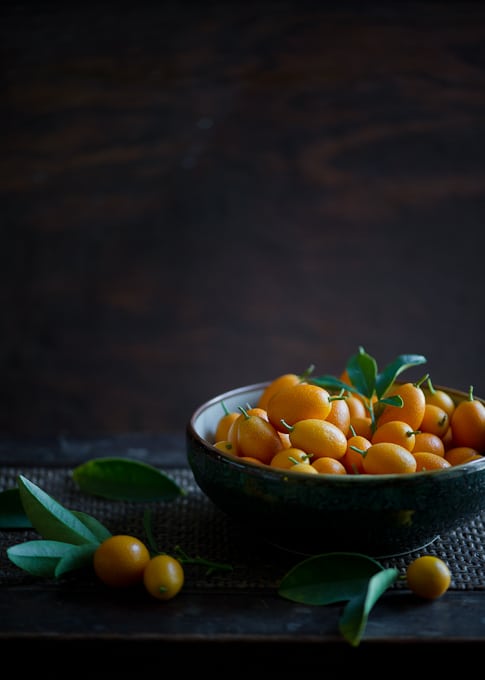
Homemade Kumquat Marmalade
In our garden loaded with citrus, we are always searching for ways to utilize their delicious bounty. Beyond the cocktails, there is always one recipe we go to the most. Kumquat marmalade. Whenever we are down to our last jar, and the tree isn’t ready with the next cycle of ripe kumquats, I start getting a little nervous. Time for careful rationing. The flavor and texture is just so perfect. A complex taste of citrus sweet with a tinge of tart and bitter. The softened delicate kumquat rinds are perfectly suspended within the marmalade jelly. It is so good!
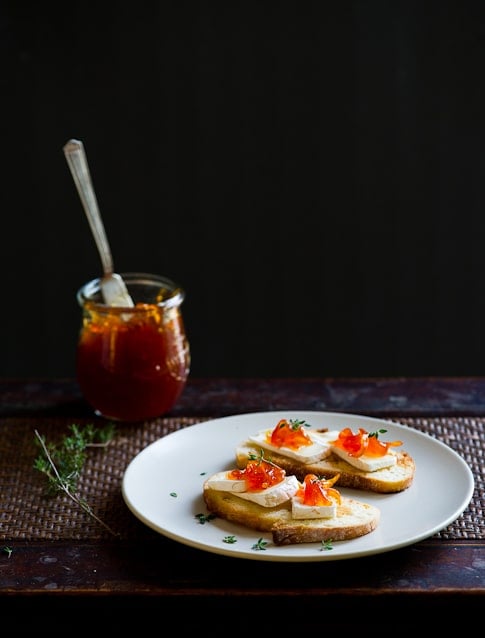
What to serve with Kumquat Marmalade
We’ve been making this recipe for years. We originally wrote about it in 2011. Back then, we found the kumquat marmalade was a perfect topping for Brie cheese and some grilled or toasted bread slices. Pasteurized Bries often tend to be a little boring, and the kumquat marmalade brought life to the cheese. Since then, we’ve found so many other things we love it on. Plain yogurt with a little kumquat marmalade it a morning staple for us. Here’s a few of our other favorites to add the marmalade to:
- Any soft, buttery cheese like Brie, Camembert, fresh mozzarella, Epoisses, goat cheeses such as chevre cheese, Saint-Andre cheese, other triple cream cheeses, etc. Add another great texture layer by serving the kumquat marmalade topped cheese on slices of grilled or pan-fried bread.
- Plain yogurt. We rarely buy flavored yogurts anymore. Adding a spoonful of the marmalade on a bowl of plain yogurt is true delight.
- Ice cream.
- Coconut shrimp. Instead of the usual sweet & sour sauce, use a bit of kumquat marmalade.
- As a sauce on fish, pork, or chicken.
- Topping for cheesecake. Plain cheesecake just became insane.
- Anytime you’d use a jam (PB&J’s, on toast, etc.)
- If you have any favorite uses for your kumquat marmalade, we’d love to hear it.
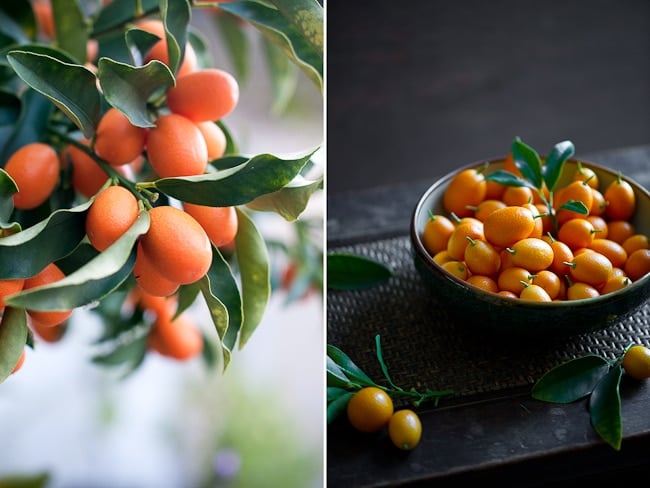
How to Know when the Marmalade is Set
Knowing when the marmalade was set to the texture we like best has always been one of our biggest struggles. Originally, when cooking the marmalade we would determine the setting point by freezing some spoons. When it looked about right, we would put a little marmalade on the spoons and quick quick chill them to see if it set to the desired consistency. It would get us close, but was more a general estimate. Most of the time it would end up too firm or too runny after jarring and cooling and we would reheat the marmalade to add water or boil a little off to get it just right. If we made back to back batches, it was easier to recognize the visual cues and get the following batches correct, but we make the marmalade when the tree has ripe fruit, so that means we are making it only a few times a year. I’d often forget the little details the next time I was making a batch months later. Then we realized making marmalade was like making caramel but with the added factor of pectin. The temperature when cooking will equate to a particular texture. As the water boils off, the temperature increases and the marmalade gets thicker. Find the right temp, and you’ll consistently find the right texture you like.
Using Temperature to Determine Marmalade Setting Point
Never make your marmalade too runny or too thick again. Using an Instant Read Thermometer or Candy Thermometer makes getting the thickness you like so much easier and consistent. Cook the marmalade in the 217°F (103°C) to 221°F (105°C) range. With each degree, the texture will be thicker and the flavor will change from a brighter citrus to a more caramel like flavor. If you go much above the 221°F temperature, the marmalade will start to get burnt and the peel will start to get chewy. It takes a full day or so for the marmalade to fully set after cooking, but you’ll have a fairly good idea of it’s final consistency when it fully cools. On side note, cooking at elevation will change the temperature of the set point. Higher elevations will set at lower temperatures. Water boils at a lower temperature at elevation, so depending on your elevation, it will set at the following consistencies 1 to 2 °F less.
- Make sure to stir just before measuring temperature to get an accurate reading. And don’t have the probe on the bag holding the seeds. The bag surface will be different than the marmalade, giving you an inaccurate reading.
- 217°F – a more fluid set. Drippy and fluid, it won’t hold shape, but the citrus flavor is the brightest.
- 218°F – a little more set. Begins to hold shape but still has some fluidity. This is our favorite consistency. The flavor is great (bright, full kumquat flavor), and it isn’t too firm. The fluidity of similar to a nice honey.
- 219°F – Starts get set as a thicker jelly. Will barely run if tilted.
- 220°F – This is considered the jelling point. Holds shape will only the slightest oozing. The flavor starts to develop more caramel overtones and less bright citrus.
- 221°F – Very thick. Holds shape and even more caramel tones. We find this texture more on the rubbery side.
Other Ways to Know When Marmalade it Set
If you don’t have a thermometer, you can still get a perfectly set marmalade. It might take a bit of experience to consistently get it how you like it, but the traditional ways still work great.
- The Visual – experience jammers will know a the right thickness by sight. The bubbles have a certain viscosity. The pop a little slower and form with a bit more effort. It is hard for a beginner to know exactly what to look for, but as you make marmalades and jams and pay attention to the details, you’ll start to know it by feel.
- Frozen Spoons or Plates (aka – the Wrinkle Test) – this is how we used to test marmalades and were fairly successful. There is still a bit of guesswork, but it will get you pretty close. Place a few spoons or a plate in the freezer while you cook the marmalade. When you think the consistency it close, place a dollop of the hot marmalade on a frozen spoon or plate. Place it back in the freezer for a minute, then push the marmalade with your finger. If it wrinkles nicely, it should be done. If it is too fluid to wrinkle, continue cooking the marmalade. After a bit of experience, you’ll know the amount of wrinkle is perfect for you.
Is Pectin needed to make Kumquat Marmalade?
Not at all. Kumquats (like most citrus) are naturally high in pectin, with the seeds having the highest concentration. By using the them in the cooking process, no artificial pectin is needed.
How to Fix a Marmalade that is Too Runny or Too Thick
Want a different texture than what you initially cooked? No problem. It happened to us all the time before we started cooking to temperature. The fix is fortunately very easy. Just re-boil the marmalade. If it is too thick, add a bit of water and bring it to a boil again. Cook it to a slightly lower temperature or thinner texture than what you did previously. If it was initially too runny, bring it to a boil and cook to a slightly higher temperature or thicker texture that what you initially did. Soon you’ll know exactly what your perfect texture is. Afterwards, place the marmalade in freshly sterilized jars.
How to Store the Kumquat Marmalade
Always begin with sterilized jars and lids. Anything stored for an extended period needs to be clean and free of bacteria. Most people will then can using a water bath method. We take a bit of simpler approach. After filling the jars and closing the lids, we will immediately stand the jars upside down. The heat from the marmalade will warm the lid seal. After about 5 minutes we will turn the jars upright again. As the marmalade cools, the lids should “pop” down. If they don’t you might need to do a hot water bath to fully seal the lids. Canning jars will vary from brand to brand, see the manufacturer instructions from your specific brand for best results.
Tools Needed to Make Marmalade
Kumquat marmalade doesn’t need many tools, but there are a few which we love and find are worth having in the kitchen. These are ones which we find have many uses in the kitchen and we love.
This has become a must have in our kitchen. Reads quickly.
Instead of making a bag with cheesecloth, these are our favorites in the kitchen.
This 3-in-1 funnel set is the best. Favorite funnel by far.
Recommendation for Jam Inspiration
For anyone interested in jamming, we occasionally find inspiration in the The Blue Chair Jam Cookbook. The instruction is fascinating and thorough. The recipes are exciting, seasonal and useful throughout the year. She lays the foundation for the user to understand the principles then have the freedom to impart their own vision into their preserves. And her recipes are inspiring and drool worthy. The book is laid out based on the seasons, perfect for the home gardeners like us.
-Todd & Diane
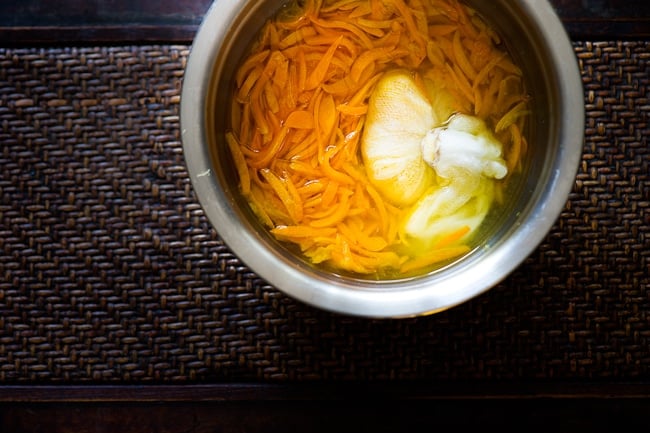
cooking with the kumquat seeds for the natural pectin
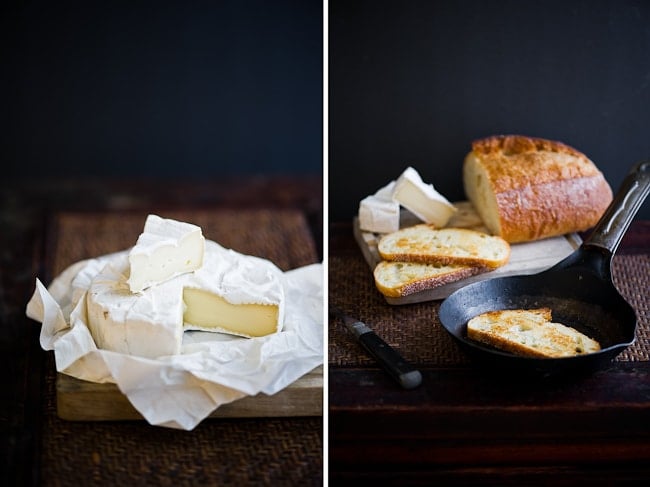
pan fry the bread, layer brie cheese & lather on the marmalade
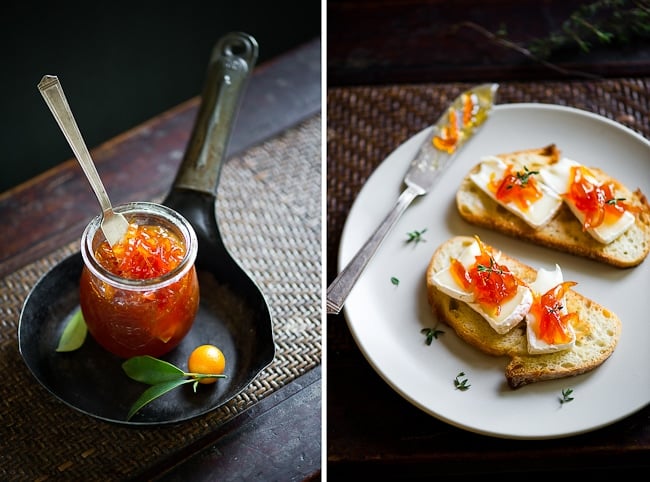
enjoy the beauty of your fruit
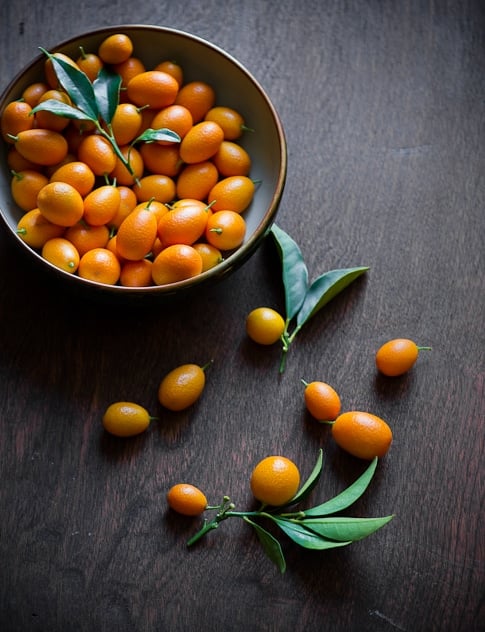
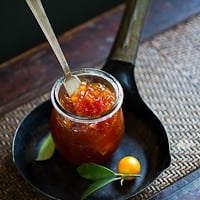
Kumquat Marmalade Recipe
Ingredients
- 1 pound (454 g) Kumquats
- 3 cups (710 ml) Water
- 1 2/3 cups (340 g) Sugar
Equipment
- Nut Milk Strainer Bag or Cheesecloth
Instructions
Day 1
- Slice the kumquats in half lengthwise.
- Over a large bowl (or saucepan if not soaking overnight – see headnote) covered with a mesh strainer, squeeze the kumquats and rub back and forth between your fingers. This will help loosen the fruit segments from the rind. Remove segments from rind. Place the fruit segments and seeds in the the mesh strainer and set aside rinds to be sliced.
- After squeezing and separating, wrap segments and seeds from the mesh strainer in a nut milk strainer bag or make a bundle from cheesecloth.
- Slice kumquat rinds into thin strips. Combine wrapped segments/seeds bundle, sliced rinds, and kumquat juice all into the large bowl (or saucepan). Pour in the 3 cups of water (add the sugar too if not soaking overnight). Cover and set aside in refrigerator for about 8 hours to soften the kumquat rinds (you can optionally skip this soak and go straight to adding the sugar and cooking the marmalade. The rind will be a little firmer and a touch more bitter, but still delicious).
Day 2
- Optional if not using a Thermometer to determine set point of marmalade, set 5 spoons in freezer for testing marmalade. See note at end of recipe for remaining instructions for making the marmalade without a thermometer.
- Put all of previous day's contents (liquid, rinds, and segment/seed bundle) into a large saucepan. Stir in the sugar.
- Bring contents up to a boil. Reduce heat to medium and boil with medium vigor for about 35-45 minutes, but it may take longer depending on your heat, pan, and quantity of kumquats. Stir occasionally to prevent the marmalade from burning.
- Test the marmalade. When the bubbles start the slightly thicken begin checking the temperature of the marmalade to determine your desired set point. Set point will be between 217°F-221°F (103°C-105°C), see note below for description of set points. Make sure to stir just before measuring temp. for accurate readings. And don’t have the probe touching the bag holding the seeds. The bag surface will be different than the marmalade, giving you an inaccurate reading.
- Pour kumquat marmalade into the canning jar(s) and process according to manufacturer’s instructions (it is easiest to use a canning funnel). Most people will can using a water bath method. We personally use a simpler approach. After filling the jars and closing the lids, immediately stand the jars upside down. The heat from the marmalade will warm the lid seal. After about 5 minutes turn the jars upright again. As the marmalade cools, the lids should “pop” down. If they don’t you might need to do a hot water bath to fully seal the lids.
Notes
Temperatures for Different Marmalade Set Points
- Make sure to stir just before measuring temperature to get an accurate reading. And don’t have the probe on the bag holding the seeds. The bag surface will be different than the marmalade, giving you an inaccurate reading.
- 217°F – a more fluid set. Drippy and fluid, it won’t hold shape, but the citrus flavor is the brightest.
- 218°F – a little more set. Begins to hold shape but still has some fluidity. This is our favorite consistency. The flavor is great (bright, full kumquat flavor), and it isn’t too firm. The fluidity of similar to a nice honey.
- 219°F – Starts get set as a thicker jelly. Will barely run if tilted.
- 220°F – This is considered the jelling point. Holds shape will only the slightest oozing. The flavor starts to develop more caramel overtones and less bright citrus.
- 221°F – Very thick. Holds shape and even more caramel tones. We find this texture more on the rubbery side.
Old Instructions
DAY 1:
-
Slice the kumquats in half lengthwise. Over a bowl covered with a mesh strainer, squeeze the kumquats and rub back and forth between your fingers. This will help loosen the fruit segments from the rind. Remove segments from rind and set both aside.
-
After squeezing, wrap segments and seeds from the mesh strainers in cheesecloth. Slice kumquat rinds into thin strips. Combine cheesecloth bundle, rinds, and kumquat juice all into the same bowl, and add the 3 cups of water. Cover and set aside in refrigerator for at least 12 hours to help soften the kumquat rinds.
DAY 2:
-
Put 5 metal spoons in a flat part of your freezer for testing the marmalade at the end of it’s cooking.
-
Put all of previous day’s contents (liquid, rinds, and cheesecloth bundle) into a medium saucepan. Stir in the sugar.
-
Bring contents up to a boil. Reduce heat to medium and boil with medium vigor for about 45 minutes, but it may take longer depending on your heat, pan, and quantity of kumquats. Stir occasionally to prevent the marmalade from burning.
-
Test the marmalade.Remove it from the heat and put half a spoonful in one of the frozen spoons. Put the spoon back in the freezer for 3 minutes. Then remove and feel the bottom of the spoon. It should feel neither hot nor cold. If still warm continue freezing for another minute or so. Tip the spoon to see if the marmalade runs. If the top layer has set to a jelly consistency it is done. If it runs, continue cooking for another few minutes and test again.
-
When finished cooking, skim off any surface foam. Let the kumquat marmalade rest for 10 minutes. Pour marmalade into one jar. Wait for a moment to see if rinds float to the top. If so, let marmalade rest for another 5 minutes. If not, then pour kumquat marmalade into the rest of the jars and process according to manufacturer’s instructions.

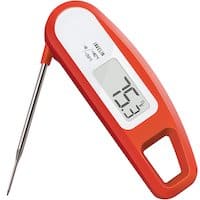
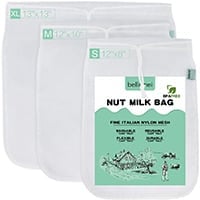
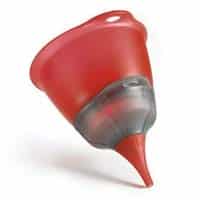
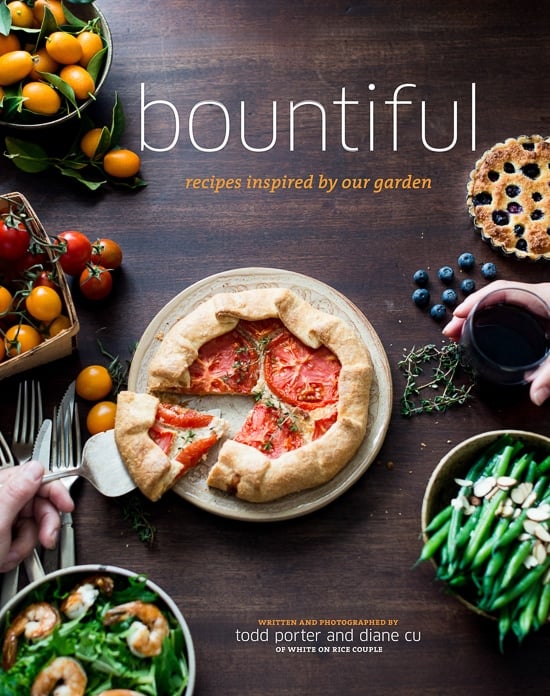
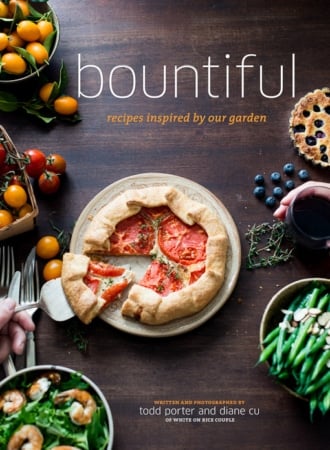


Thank you for this recipe. I recently made a batch from our little Bangkok balcony Kumquat tree and it turned out great! Here is my image of the finish marmalade and you are correct, it is wonderful with brie… and some homemade beer bread! Thanks again.
https://flic.kr/p/2ocM1Uc
Look great Mark! thanks for sharing your beautiful images.
I hope you are still answering comments… I have used your recipe for the last several years, absolutely love it! however, this year my kumquats yielded a lot more juice than any other year. How do I know how much water to add? is there a water to juice ratio? Thanks in advance!
Hi Lisa,
So glad you love the kumquat marmalade too. It is our favorite recipe to make from our tree too. We have had juicy years too, but don’t make any adjustments to the water. It might take a little longer to boil down, but the timing will hardly be noticeable. Cook it down until it tests to the consistency that you like. It might just be extra delicious with the extra juice!
thank you! appreciate the quick reply. I am boiling it today. 🙂
Super recipe. At 40 minutes it bunt but the caramelised flavour was good. I need to watch it closely after 35 minutes. Will try it again. I used diabetic friendly sugar instead of the regular. I may use little less next time. Overall enjoyed making the marmalade. Thanks for sharing.
Excellent! I did have to add about 30min to the cook time but what a great recipe. I’m actually eating now on English muffin with cream cheese, yum!
Thanks Christy! Love english muffins!
At last found a recipe like my mother made. Thanks a million.
Thanks Shirley!
Great recipe second time around, first time added a bit of ginger and some lemon juice to make it less sweet.
Moving into a new home is exciting but who knew what a Kumquat was until I owned my very own tree! Thank you for offering this great recipe online and making my first ever experience of domestication a true success!